-
0 items in quote
No products in the Quote Basket.
SMART CUT® 15V9
DIAMOND & CBN WHEELS
- Applications: Tool and cutter grinding, End mill sharpening, Profile grinding, Fluting and gashing of tools, Side grinding where profile accuracy is required
- Bond Availability: Resin Bond, Hybrid Bond
- Available in: Diamond, CBN
- Core Materials: Aluminum, Steel, composite, sintered, abrasive
- Size Availability: 1″ (75mm) – 10″ (254mm)
- Diamond Grit Sizes: 25 mesh to 3 microns
- Diamond Concentration: low, medium & high (from 10 con to 150 con)
- Standard Lead Times: 4 to 5 weeks.
- Expedited lead time: 1to 2 weeks is also available at additional cost
DESCRIPTION
SPECIFICATIONS
ADVANTAGES
INDUSTRIES USED IN
FAQ
ACCESSORIES
HOW TO ORDER
DESCRIPTION
Shape:
- Toroidal or Tapered Edge: The 15V9 wheel shape is characterized by a toroidal (donut-like) or tapered edge that is angled relative to the face of the wheel. This unique profile allows for precision grinding in complex profiles and hard-to-reach areas of a workpiece.
- Concave Side: The wheel often has a concave side that helps in grinding recesses and complex shapes with precision.
Edge:
- Angled Profile: The edge of the wheel, which makes contact with the workpiece, is angled. The specific angle is designed to facilitate the grinding of specific profiles and often helps with clearance during grinding operations.
- Abrasive Material: The edge is embedded with diamond or CBN (Cubic Boron Nitride) abrasive material, which is selected based on the material to be ground. Diamond is used for non-ferrous materials, while CBN is utilized for ferrous materials.
Face:
- Peripheral Surface Grinding: The face or the periphery of the wheel is the part that performs the grinding. It’s engineered to maintain its shape throughout the grinding process and can be dressed to restore or modify its profile as needed.
- Coolant Usage: The face design may also accommodate the use of coolants, which help in reducing heat buildup and removing swarf (grinding debris) during the grinding process.
Diameter and Thickness:
- Diameter: The overall diameter of 15V9 wheels can vary, but common sizes may range from as small as 75mm (3 inches) to over 200mm (8 inches) or more for different applications. The choice of diameter typically depends on the specific requirements of the grinding machine and the workpiece.
- Thickness: The thickness of the grinding wheel is usually much smaller than the diameter and is chosen based on the depth of cut required and the intricacy of the workpiece profile. A thinner wheel would be selected for detailed, intricate profiles, whereas a thicker wheel would be used for more substantial material removal.
Other Considerations:
- Mounting Hole: The central mounting hole must be sized to fit the spindle of the grinding machine securely. This hole’s size and tolerance are crucial for proper wheel balance and performance.
Application for 15V9 Diamond & CBN Wheels:
The 15V9 Diamond & CBN (Cubic Boron Nitride) Grinding Wheels are designed for a wide array of high-precision, high-efficiency applications. Here are some of their primary uses:
- Tool and Cutter Grinding: These wheels are commonly used for sharpening and producing cutting tools like end mills, drills, and other precision tools. Their shape allows for the grinding of complex forms and angles with precision.
- Carbide Tooling: Diamond wheels are particularly suited for grinding carbide tooling, which requires a wheel that is harder than the material being ground. They provide a fine finish and sharp edges on the tools.
- High-Speed Steel (HSS) Applications: CBN wheels are used to grind high-speed steel, which is often used in tooling for its ability to withstand high temperatures during cutting.
- Profile Grinding: The wheels are ideal for the precise profiling of cutting tools and components. They maintain a high level of precision and finish.
- Fluting and Gashing: In the production of drills and end mills, fluting and gashing require wheels that can produce precise contours and provide a clean, sharp cutting edge. The 15V9 wheels excel in these tasks.
- End Mill Sharpening: The precise geometry of end mills requires a wheel capable of grinding complex forms with accuracy. The 15V9 is designed for such tasks, ensuring the integrity of the mill’s profile.
- Insert Grinding: For the production of carbide or other hard material inserts used in machining and milling, these wheels provide the necessary hardness and precision.
- Sharpening of Cutting Tools: Diamond and CBN wheels offer the essential qualities for sharpening high-quality cutting edges on various tools, including saw blades, router bits, and planer blades.
- Precision Engineering: They are used in the aerospace, automotive, and tool-making industries where precision-engineered parts require exact tolerances and superior surface finishes.
- Medical Device Manufacturing: In the production of medical devices, the wheels are used to ensure the precision and surface quality required in this critical field.
- Electronics Industry: They are used in grinding the hard materials used in electronic components, like semiconductors.
- Jewelry and Watchmaking: Precision grinding wheels are also used for forming and polishing of precious metals and gemstones in the jewelry industry.
- Ceramic and Glass Grinding: Diamond wheels are also used for the precision shaping and finishing of ceramics and glass materials.
- Woodworking Tooling: Particularly for carbide-tipped saws and tools, diamond grinding wheels provide the necessary durability and sharpness.
- Gear Manufacturing: CBN wheels are used in gear grinding to produce precise gear profiles with excellent surface finish.
- Bench Grinding: For maintenance, reshaping, and sharpening of tools in bench grinding operations.
SPECIFICATIONS
- Shape: The 15V9 wheel profile, with its tapered, dish-shaped edge, is master-crafted for intricate tool and cutter applications, providing exceptional clearance and access to complex geometries.
- Applications: Tool and cutter grinding, End mill sharpening, Profile grinding, Fluting and gashing of tools, Side grinding where profile accuracy is required
- Bond Availability: Resin Bond, Hybrid Bond
- Available in: Diamond, CBN
- Core Materials: Aluminum, Steel, composite, sintered, abrasive
- Size Availability: 1″ (75mm) – 10″ (254mm)
- Diamond Grit Sizes: 25 mesh to 3 microns
- Diamond Concentration: low, medium & high (from 10 con to 150 con)
- Standard Lead Times: 4 to 5 weeks.
- Expedited lead time: 1to 2 weeks is also available at additional cost
Tolerances:
- 1. Diameter Tolerance: ±0.005 inch (±0.127 mm)
- 2. Thickness Tolerance: ±0.001 inch (±0.025 mm) to ±0.005 inch (±0.127 mm).
- 3. Hole Size (Bore) Tolerance: +0.0000 inch and -0.0020 inch (+0.000 mm and -0.0508 mm).
- 4. Concentricity and Runout: TIR (Total Indicator Reading) for concentricity and runout is typically within 0.002 inch (0.05 mm).
- 5. Profile Tolerance: few micrometers
- 6. Side Runout: 0.002 inch (0.05 mm).
ADVANTAGES
Tab Content
INDUSTRIES USED IN
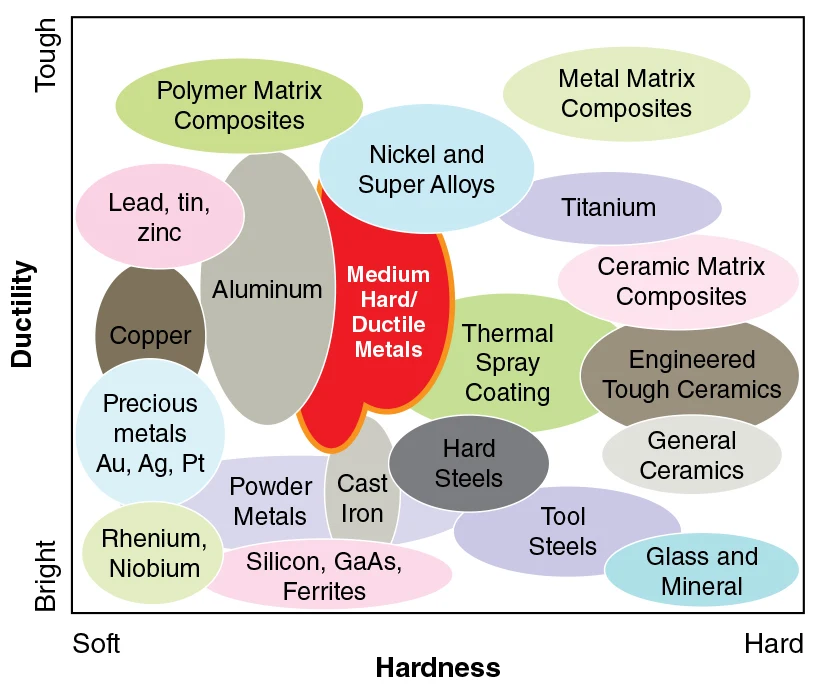
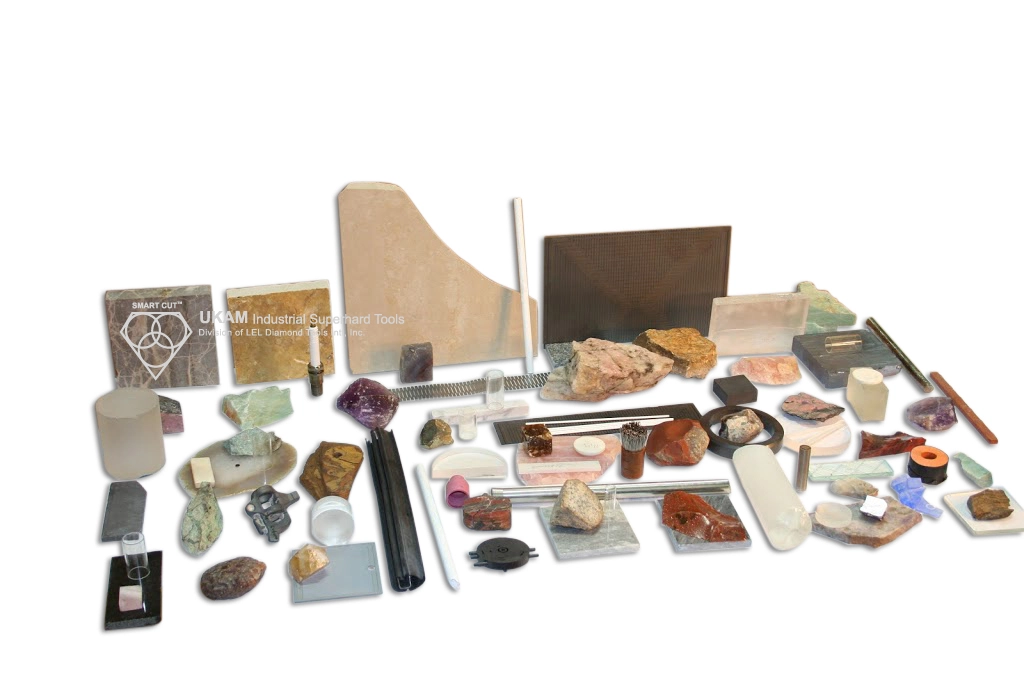
INDUSTRIES USED IN:
- Advanced Ceramics
- Composites
- Glass
- Geology
- Quartz
- Materials Research
- Medical Devices
- Metallography
- Photonics / Optics
- Semiconductor
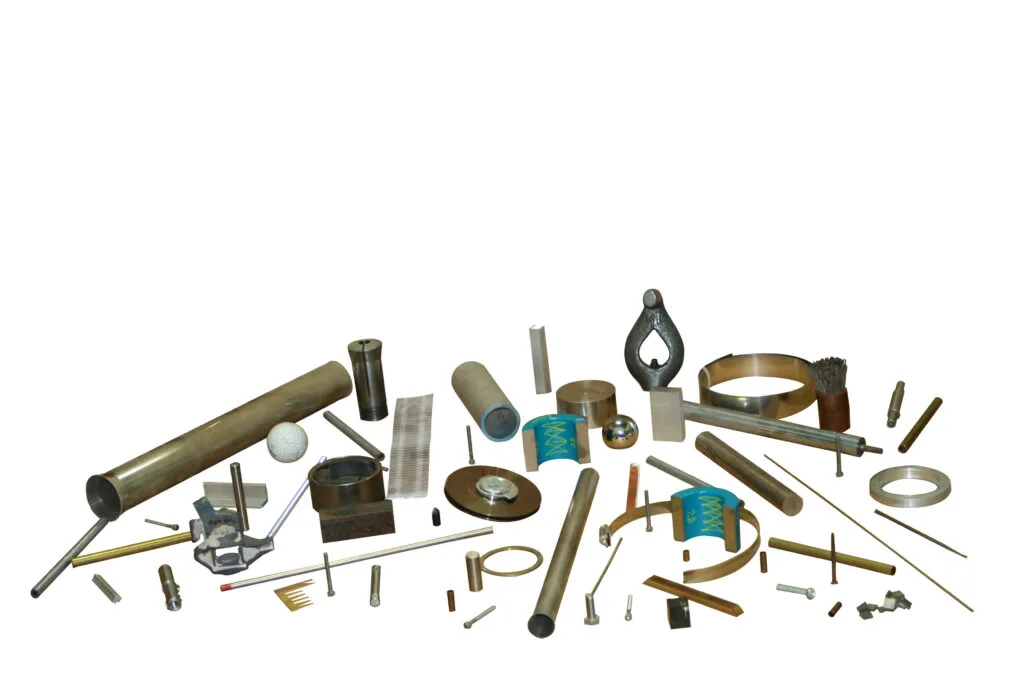
Ferrous & Non-Ferrous Metals:
- Plain Carbon Steels
- Electronic Packages
- Stainless Steels Plastics
- Tool Steels Fasteners
- Aluminum Refractories
- Copper Base Alloys Integrated Circuits
- Magnesium Thermal Spray Coatings
- Titanium Metal Matrix Composites
- Biomedical Wafers
- Petrographic
- PCB.s Ceramics
FAQ
The 15V9 Diamond Wheels are suitable for grinding hard, non-ferrous materials, such as carbide, ceramics, glass, and other abrasive materials. The CBN Wheels are designed to grind ferrous materials such as hardened steels and high-speed steels.
These wheels are compatible with various CNC grinding machines, precision grinders, and tool and cutter grinders. It’s important to check the specific machine compatibility based on the wheel’s dimensions and mounting requirements.
Yes, custom sizes are available upon request. You’ll need to provide the required dimensions, tolerances, and any other specifications your particular application may need.
Always refer to the machine’s manual Ensure that the wheel is properly mounted and secured, and that you are following all safety procedures.
Operating speeds vary based on the wheel size and composition. Always adhere to the maximum speed rating provided and consult our engineering team for recommended speed for your specific grinding task.
Always wear appropriate personal protective equipment (PPE), including safety glasses, gloves, and hearing protection. Ensure the work area is secure, the wheel is free from damage, and the machine guards are in place.
Grit size selection depends on the material being ground and the finish required. Coarser grits are used for rapid material removal, while finer grits are used for a smoother finish. Consult with our engineering team for recommendations on grit size for your specific application.
Store the wheels in a dry, temperature-controlled environment away from direct sunlight, heat, and cold. Keep them in their original packaging to prevent damage.
Yes, both Diamond and CBN wheels can be dressed. Use a dressing stick appropriate for the type of wheel, or a machine dresser, and follow the dressing procedure recommended by the wheel manufacturer.
The life of a grinding wheel depends on the frequency of use, the materials being ground, and the operating conditions. Inspect the wheel regularly for wear and replace it when it no longer performs satisfactorily or if it becomes damaged or worn down to the manufacturer’s recommended limit.
Apart from regular dressing, the wheels should be inspected for signs of wear, damage, or imbalance. Keep the wheels clean and free of any buildup that could affect performance.
CBN wheels have a significantly longer life and provide a consistent cutting edge compared to conventional wheels. They also allow for higher speed operations and can produce finer finishes with less heat generation on the workpiece.
Yes, the 15V9 wheels can be used for both wet and dry grinding, although wet grinding is generally recommended to improve the wheel life and to reduce dust and heat.
These wheels are generally more environmentally friendly than some other abrasive products because they last longer and reduce the need for frequent replacement. Additionally, when used with proper coolant, they minimize airborne particles.
If a wheel becomes out of balance, it should be rebalanced using the proper balancing equipment. Operating an unbalanced wheel can be dangerous and can lead to poor surface finishes and decreased wheel life.
Yes, 15V9 wheels come with various bond types, including resin, hybrid and other bonds, each offering different performance characteristics suitable for various applications and materials.
Signs that it’s time to dress the wheel include a decrease in grinding performance, changes in the sound of the grind, visible glazing on the wheel, or any irregularities on the surface.
While not excessively fragile, diamond and CBN wheels should be handled with care to prevent damage. They should be shipped in proper packaging to avoid impacts that could cause chipping or cracking.
It’s not recommended to use the same wheel for different materials, especially if they require different grinding dynamics. Using the same wheel can compromise its effectiveness and the finish of the materials.
If stored properly, the 15V9 Diamond & CBN Grinding Wheels have an indefinite shelf life. However, it’s a good practice to use the wheels within a few years from the date of manufacture to ensure the best performance.
Yes, materials that can cause a chemical reaction with the bond or abrasive should be avoided. For example, grinding steel with a diamond wheel can lead to carbon dissolving into the steel and eroding the diamond grit.
Disposal should be carried out in accordance with local regulations. Contact local waste management services for proper disposal methods, as the wheels are made of materials that may require special handling.
Depending on the wheel’s condition and the bond type, some wheels can be reconditioned or re-profiled
Yes, 15V9 wheels are specifically designed for precision profile grinding. Their shape and construction allow for detailed and accurate grinding operations.
High temperatures can cause the bond to break down and may affect the integrity of the abrasive grains. It’s important to use adequate coolant and proper grinding parameters to manage temperature during grinding.
The surface finish can be adjusted by selecting the appropriate grit size, using the correct wheel speed, feed rate, and by dressing the wheel properly to achieve the desired finish.
The profile of the wheel determines the shape of the grind and can influence factors such as contact area, cutting action, and chip clearance. Correct wheel profile is crucial for achieving the desired grinding result.
Yes, these wheels are often used for sharpening high-speed steel and carbide tools due to their precision and the superior finish they can provide.
The best wheel speed depends on the material hardness, wheel diameter, and desired outcome. Consult our engineering team for the optimal speed for various materials.
Store the wheels in a cool, dry place away from extreme temperatures and humidity to prevent the bond from deteriorating or the wheel from warping.
The 15V9 wheel has a unique toroid shape that is designed for certain profile grinding tasks, offering advantages in angle precision and access to intricate part geometries.
Prevent chipping by ensuring the wheel is properly dressed, operating at the correct speed, and not applying excessive force during grinding. Also, ensure that the workpiece is securely fixed.
Yes, a new wheel should be properly conditioned or broken in to expose fresh abrasive grains and to ensure the wheel performs optimally from the start.
Yes, these wheels are versatile and can be used on both manual and CNC grinding machines as long as the mounting and operating parameters are compatible.
An unbalanced wheel can cause vibration, leading to a poor surface finish, increased wear on the machine, and reduced operator comfort. Wheel balancing is essential for precision grinding.
Using the wrong bond type can result in poor performance, such as rapid wear, suboptimal surface finishes, or damage to the workpiece and wheel.
15V9 wheels are ideal for precision grinding, shaping, and finishing applications, including tool and cutter sharpening, end mill and drill bit reconditioning, profile grinding, and flute grinding.
Choose diamond wheels for grinding carbide, ceramics, and other non-ferrous materials. Opt for CBN wheels for grinding hardened steels, high-speed steels, and ferrous alloys.
Yes, the design of the 15V9 wheel allows for both profile and plunge grinding applications.
Wheel glazing, unusual noises, burning of the workpiece, reduced grinding performance, or visible wheel wear are indicators that the wheel needs dressing.
While tolerances can be application-specific, 15V9 wheels are capable of achieving tolerances within a few microns, depending on the machine, wheel specification, and operator skill.
Indicators of a worn-out wheel include extensive physical wear visible on the wheel, consistent underperformance even after dressing, or any form of damage such as cracks or chips.
Regular dressing and correct storage will maintain the wheel shape and dimensions. If the wheel loses its shape, it may need to be professionally trued.
Common mistakes include using the wrong wheel type for the material, incorrect mounting, excessive force, and improper wheel speed, which can all lead to premature wheel wear or damage.
ent
Extreme temperatures and humidity can affect the wheel bond and its performance. It’s best to store and use these wheels in controlled environments.
15V9 wheels are generally not designed for side grinding due to their angled edge and profile. They are best used for the applications for which they were specifically designed.
Recycling of industrial grinding wheels varies depending on the material and local regulations. Consult with the manufacturer or local waste management authorities for proper recycling practices.
Spindle speed will depend on the wheel’s diameter and the material being ground. Refer to the manufacturer’s specifications and recommended operating speeds.
Apply grinding fluid directly to the cutting area to ensure efficient cooling and chip removal. The type of fluid and flow rate can significantly affect the grinding quality and wheel life.
Use consistent grinding parameters, maintain a regular dressing schedule, and ensure the machine and wheel are in good condition.
Wheel hardness influences the self-sharpening ability of the wheel. A harder wheel retains its grit longer but may not self-sharpen as effectively, which can lead to glazing. Conversely, a softer wheel will self-sharpen more easily but may wear down faster.
Yes, 15V9 wheels come in a variety of grit sizes to accommodate different levels of finish and material removal rates.
Consider the material to be ground, the required finish, the grinding machine capabilities, the hardness of the wheel, and the complexity of the component geometry.
Minor damage may be corrected by dressing, but if the wheel is cracked or extensively chipped, it should not be used. Consult with our engineering team if there’s any uncertainty about wheel integrity.
Incorrect wheel speeds can lead to suboptimal grinding results, wheel damage, increased wear, and potential safety hazards.
Dressing frequency depends on the material being ground, the amount of material removal, and the desired surface finish. Monitor the grinding process and wheel condition to determine the right interval.
Yes, we offeroffer custom profiling services for wheels to meet specific application needs.
Check the dressing of the wheel, ensure that it is properly balanced and mounted, verify the grinding parameters, and inspect the workpiece fixture for rigidity.
Synthetic diamond wheels typically offer more consistent performance due to the uniformity of the synthetic diamond crystals. Natural diamond may have variations that affect the grinding process.
Yes, if the machines have compatible mounting and operational specifications. However, it’s important to adjust the grinding parameters to each machine’s capabilities.
ACCESSORIES
Showing 1 – -1 of 16 results Showing all 16 results Showing the single result No results found
Sort by Name A – Z
Filters Sort results
Reset Apply
Image | Item No. | Description | Price | Quantity | Add to cart |
|---|---|---|---|---|---|
Color: 5/8″-11″ thread. Fits into drill press chuck. Shank adapter threads into 5/8″-11″ female thread of diamond drill. Can be used with any other tool with 5/8″-11″ thread. | $26.72 | Max: Min: 1 Step: 1 | |||
Color: 5/8″-11″ thread. Fits into drill press chuck. Shank adapter threads into 5/8″-11″ female thread of diamond drill. Can be used with any other tool with 5/8″-11″ thread. | $22.46 | Max: Min: 1 Step: 1 | |||
1 Gallon Blue SMART CUT® General Materials Formula Synthetic Water Soluble Coolant | $99.81 | Max: Min: 1 Step: 1 | |||
1 Quart Blue SMART CUT® General Materials Formula Synthetic Water Soluble Coolant | $34.81 | Max: Min: 1 Step: 1 | |||
5 Gallons Blue SMART CUT® General Materials Formula Synthetic Water Soluble Coolant | $317.41 | Max: Min: 1 Step: 1 | |||
55 Gallons Blue SMART CUT® General Materials Formula Synthetic Water Soluble Coolant | $1,745.00 | Max: Min: 1 Step: 1 | |||
1/2″ x 1/2″ x 6.0″ White Recommended for coarser grits found in segment wheels, core drills, or Blanchard grinding. Excellent performance on 120 grit tools. | $8.65 | Max: Min: 1 Step: 1 | |||
1.0″ x 1.0″ x 6.0″ White Recommended for coarser grits found in segment wheels, core drills, or Blanchard grinding. Excellent performance on 120 grit tools. | $15.99 | Max: Min: 1 Step: 1 | |||
1/2″ x 1/2″ x 6.0″ White For use on diamond tools 150 to 220 Grit Size. | $8.65 | Max: Min: 1 Step: 1 | |||
1.0″ x 1.0″ x 6.0″ Black Recommended for use in Diamond Tools 150 Grit Size (mesh size) or finer. | $15.39 | Max: Min: 1 Step: 1 | |||
2.0″ x 2.0″ x 6.0″ Black Recommended for use in Diamond Tools 150 Grit Size (mesh size) or finer. | $39.47 | Max: Min: 1 Step: 1 | |||
1.0″ x 1.0″ x 6.0″ Black Recommended for coarser grits found in segment wheels, core drills, or Blanchard grinding. Excellent performance on 120 grit tools. | $15.99 | Max: Min: 1 Step: 1 | |||
2.0″ x 2.0″ x 6.0″ Black Recommended for coarser grits found in segment wheels, core drills, or Blanchard grinding. Excellent performance on 120 grit tools. | $39.47 | Max: Min: 1 Step: 1 | |||
$154.87 | Max: Min: 1 Step: 1 | ||||
$154.87 | Max: Min: 1 Step: 1 | ||||
$235.00 | Max: Min: 1 Step: 1 |
HOW TO ORDER
What We Do
we manufacture custom tools to fit your specific requirements and specifications. We have the capability to manufacture over 30,000+ different types of custom diamond & cbn tools and consumables to better fit your particular material, application, specifications, and requirements
Why Custom Tools?
Not all requirements are the same. We manufacture tools to fit your particular equipment, tolerances, surface finish, life span, and overall see the difference tools optimized for your application can make?
How We Work
We will work with you to determine your needs, and develop the right bond formulation, concentration, and grit sizes. Our tools are designed and specially selected to provide maximum possible tool life, for your desired cut quality and speed.
Custom Tool Manufacturing Process
The following process describes custom tool manufacturing process form initial first inquiry to final delivery.

DISCOVERY
We discuss your specific requirement in detail to determine the best solution for your needs.

RECOMMEND SOLUTION
We provide you with recommend options for your application based on your requirements along with quotation and lead time.

PREPAIRE TO IMPLEMENT
When you are ready to order, we send you confirmation of the tool specification always in writting. Your order is placed in que to be produced within the quoted lead time.

IMPLEMENT & DELIVER
The finished products go through quality control process and also inspected for conformance to specification agreed upon. The order is packaged and shipped to you using your requested shipping method. Certificate of conformance or any other documentation can be provided upon request.

SERVICE &
SUPPORT
We follow up with you to receive feedback on the tool performance. We also provide usage recommendatios and technical support if needed.
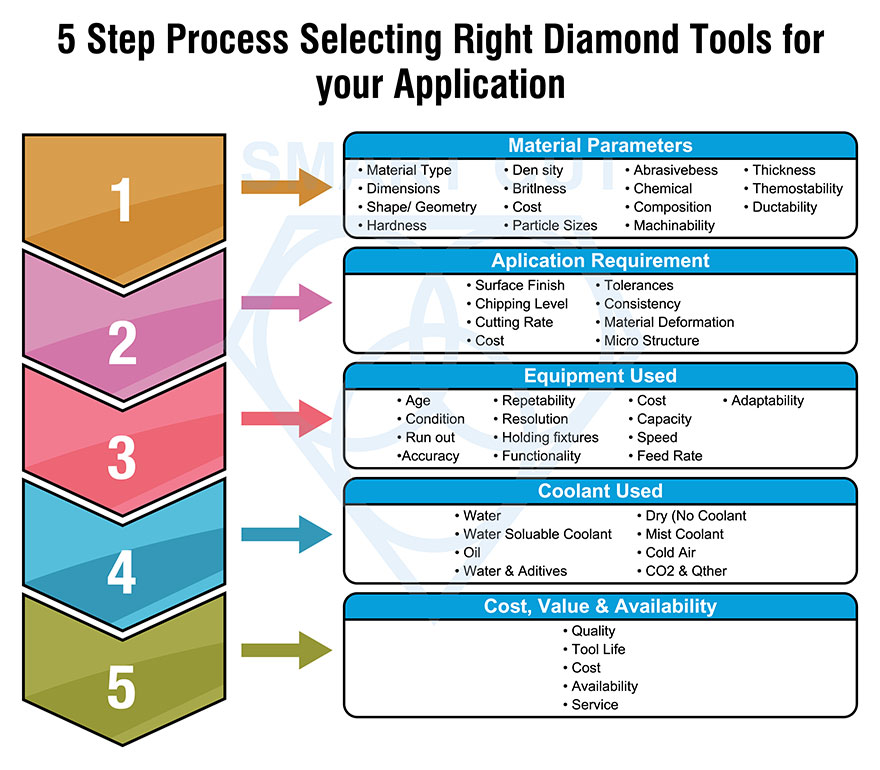
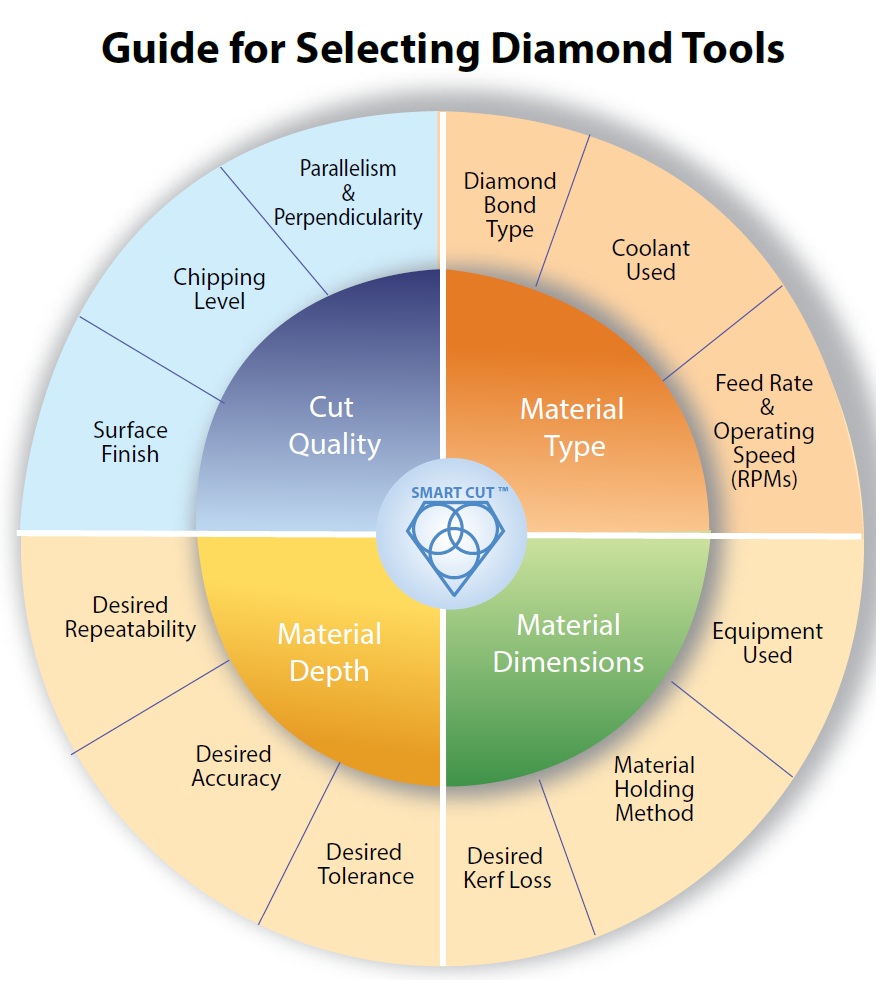
Custom Diamond and CBN wheel FAQ
To place an order, you can contact our customer service team via phone, email, or our website. You will need to provide specific details about your grinding application, including material to be ground, required wheel dimensions, and desired grit size.
Yes, we are happy to help. We will send you a question are asking many questions about your requirements, how the tool will be used and the usage environment. This information is very important for helping us understand your unique specifications and requirements. The more information you can provide the more accurate recommendation and solutions we can provide.
Usually there is no minimum order for custom tools, with few acceptations. We encourage you to try small quantity to make sure you are happy with the tool performance first. As additional fine tuning and improvements can be made based on your feedback.
Lead time varies depending on tool specification and current schedule. Usually the lead time range can be from 1 to 5 weeks. expedited lead time of 1 to 2 weeks is usually available at additional cost if needed
Prices are based on tool specification, tolerances, quantity and lead time. Our prices are pretty competitive for world market. We regularly export our products to dozens of different countries across all continents. Usually custom products in small quantity the pricing is usually higher then standard of the shelf products which are mass produced in large quantities.
We can provide hand sketch if needed. if you need drawing we can create in solid works or auto cad for a small fee which may be reimbursable upon receipt of order
Over many decades we have made and sold thousands of different types of unique and one of a kind tools for almost every application. we maintain records of bond formulations and specifications used over many years we have also acquired the “know how” of several other US tool manufacturers that have produced custom tools over many decades, some going far back as to 1960’s. we also have our own R & D research program and we regularly work with different research originations and outside consultants. Most of the time we produce the right tool formulation first time, but sometimes we can make additional improvements second and third time around. Our goal is to make you happy
We ask lot of detailed question about tool specification and your usage process. Sometimes it may be worthwhile for you to send us your used tool so we can inspect it.
Yes we can provide basic recommendations and recommended usage information. If you need specific hands on approach such as “process development” this can be done on case by case based for a fee. If we are not able to help we can often recommend independent outside consultant or organization that can assist.
For a custom wheel order, you should provide the following information:
• Type of wheel (Diamond or CBN)
• Wheel dimensions (diameter, thickness, and arbor hole size)
• Grit size
• Material to be ground
• Grinding machine details
• Desired surface finish
Yes, you can request a specific bond type based on your grinding application. Common bond types include resin, vitrified, metal, and electroplated.
The lead time for custom wheels varies depending on the complexity of the wheel and our current production schedule. Typical leads times range from 4 to 5 weeks. Expedited lead time of 1 to 2 weeks is also available at additional cost if needed. Our customer service team will provide an estimated delivery date when you place your order.
Due to the custom nature of these wheels, they are typically non-returnable. However, if the wheel does not meet the specified requirements or is defective, we will work with you to resolve the issue.
Yes, you can order a sample wheel to test on your application before placing a bulk order. We highly encourage that you test the wheel for your particular application in your environment. Please contact our customer service team for more information.
Yes, we offer discounts for bulk orders. Please contact our sales team for more information.
Proper care and maintenance are essential to ensure the longevity and performance of your wheel. You should regularly clean the wheel, check for any damage, and use it at the recommended speed. Additionally, it’s important to use the correct coolant and dressing tools.
Yes, we can customize the wheel profile to meet your specific requirements. Please provide detailed drawings or specifications of the profile you need when placing your order.
Diamond wheels are suitable for grinding non-ferrous and non-metallic materials such as glass, ceramics, and tungsten carbide. CBN wheels are ideal for grinding ferrous materials such as steel, cast iron, and nickel-based alloys.
Yes, we have a team of experienced engineers and technicians who can provide technical support and advice for your specific grinding application.
Yes, you can request specific tolerances for your custom wheel. Please provide the required tolerances when placing your order, and we will do our best to meet your specifications.
Once your order has been placed, you will receive an order confirmation with a tracking number. You can use this number to track the status of your order on our website or contact our customer service team for updates.
We will do our best to accommodate any changes to your order, but please note that changes may not be possible once the production process has started.
We accept various payment methods, including credit card, PayPal, and bank transfer. Please contact our sales team for more information.
Cancellations are handled on a case-by-case basis. If the production process has not started, we may be able to cancel your order. However, once production has begun, cancellations are generally not accepted.
A balanced wheel is essential for optimal performance and safety. If you notice any vibrations or irregularities during operation, your wheel may be out of balance. Please contact our technical support team for assistance with balancing your wheel.
Yes, we offer a warranty on our custom wheels. The length and terms of the warranty will depend on the specific wheel and application. Please contact our sales team for more information.
The grit size should be selected based on the material to be ground and the desired surface finish. A coarser grit is generally used for rapid material removal, while a finer grit is used for a smoother finish. Our technical support team can help you choose the right grit size for your application.
Yes, we can manufacture custom wheels to fit specific brands and models of grinding machines. Please provide the make and model of your machine when placing your order.
Yes, we ship custom wheels internationally. Please contact our sales team for more information on shipping options and costs.
Resin bonds are flexible and suitable for grinding materials that are prone to heat damage. Vitrified bonds are rigid and offer high precision grinding. Metal bonds are durable and suitable for grinding hard materials. Electroplated bonds have a single layer of abrasive and are used for precision grinding.
A custom wheel may be necessary if your application requires specific dimensions, grit sizes, bond types, or shapes that are not available in standard wheels. Our technical support team can help you determine if a custom wheel is necessary for your application.
Diamond is the hardest known material and is suitable for grinding non-ferrous and non-metallic materials. CBN is the second-hardest known material and is suitable for grinding ferrous materials.
Yes, you can request a specific concentration of Diamond or CBN in your custom wheel. The concentration will affect the wheel’s performance and life.
Please refer to local regulations and guidelines for disposing of grinding wheels. In general, worn-out wheels should be treated as industrial waste and disposed of accordingly.
Yes, we can manufacture custom wheels with specific colors or logos. Please provide your requirements when placing your order.
Yes, we can manufacture a custom wheel with different abrasive grains to suit specific grinding applications.
Regularly clean your custom wheel to remove any accumulated grit, dust, and swarf. Avoid exposing the wheel to moisture to prevent corrosion or damage to the bond. Store the wheel in a dry and cool place away from direct sunlight.
Always wear safety goggles, gloves, and other appropriate personal protective equipment when using any grinding wheel. Follow the manufacturer’s guidelines and safety instructions for your specific grinding machine.
The performance of a custom wheel can be measured in terms of material removal rate, wheel wear rate, surface finish quality, and overall efficiency.
The wheel speed will depend on the specific grinding application, material to be ground, and the wheel’s dimensions. Our technical support team can help you determine the optimal wheel speed for your application.
Yes, you can specify the hardness level for your custom wheel, which will affect its grinding performance.
Our custom wheels comply with industry standards and regulations, including ANSI, ISO, and OSHA. Specific certifications may vary depending on the wheel and application.
Yes, you can request a custom wheel with specific porosity to achieve desired grinding performance and coolant flow.
You can conduct a trial run with the custom wheel on your grinding machine, following all safety guidelines. Observe the wheel’s performance in terms of material removal rate, surface finish quality, and overall efficiency. Our technical support team can assist you in evaluating the wheel’s performance.
Factors that affect the life of a custom wheel include the type of material being ground, the grit size, bond type, wheel speed, and coolant usage.
Yes, you can specify whether the custom wheel is intended for wet or dry grinding, and we will manufacture the wheel accordingly.
The bond type should be selected based on the material to be ground, desired surface finish, and grinding machine characteristics. Our technical support team can help you choose the right bond type for your application.
The minimum order quantity for a custom wheel depends on the specific requirements and dimensions of the wheel. For most wheels there is no minimum order quantities. Please contact our sales team for more information.
Yes, you can request a quote for a custom wheel through our website by providing the specific requirements and dimensions for your wheel.
Yes, you can specify the face width or thickness for your custom wheel, and we will manufacture the wheel accordingly.
The wheel bond plays a crucial role in holding the abrasive grains together. The bond type affects the wheel’s wear rate, grinding performance, and the finish quality of the workpiece.
Yes, we can manufacture custom wheels with specific profile shapes to meet your unique grinding needs. Please provide a detailed drawing or specifications of the profile shape when placing your order.
If you’re not satisfied with the performance of your custom wheel, please contact our customer service team immediately. We will work with you to address any issues and find a suitable solution.
The abrasive concentration in a wheel is typically measured as a percentage of the volume of abrasive grains to the total volume of the wheel. A higher concentration means more abrasive grains and typically results in a longer wheel life and better performance.
The wheel’s hardness affects its ability to resist wear and maintain its shape during grinding. A harder wheel typically lasts longer but may produce a rougher surface finish.
Yes, we can manufacture custom wheels with specific arbor hole sizes to fit your grinding machine.
Yes, we can manufacture custom wheels with specific grinding face geometries to meet your unique requirements. Please provide detailed drawings or specifications when placing your order.
Factors to consider when choosing the grit size include the material to be ground, desired surface finish, and grinding operation type. A finer grit is typically used for finishing operations, while a coarser grit is used for roughing operations.
The wheel shape affects how the abrasive grains interact with the workpiece, influencing the grinding performance and resulting surface finish.
Yes, we can manufacture custom wheels designed specifically for grinding materials such as glass or ceramics.
Wheel balance is critical for achieving optimal grinding performance and preventing vibration and machine wear.
Yes, you can specify the bond hardness for your custom wheel, which will affect its grinding performance.
The wheel diameter affects the peripheral speed of the wheel, which in turn influences the grinding performance and resulting surface finish.
The type of abrasive grain (e.g., Diamond, CBN, aluminum oxide) affects the wheel’s hardness, sharpness, and heat resistance, which in turn influences the grinding performance.
Yes, we can manufacture custom wheels with specific profiles for gear grinding applications. Please provide detailed specifications or drawings when placing your order.
Factors to consider when choosing the bond type include the material to be ground, grinding operation type, wheel speed, and desired surface finish.
Wheel speed affects the material removal rate, heat generation, and resulting surface finish of the workpiece.
Yes, we can manufacture custom wheels with specific porosity levels to meet specific grinding requirements.
Features
- Universal Application
- Longer Life
- Precision Tolerances
- Easy to Use
- Almost Unlimited Number of Options
- Custom Manufacturing
Benefits
- Better Surface Finish
- Less Chipping
- Minimum & No Material Deformation
- No Glazing
- Minimum Heat Generation
- Faster & Freer Cutting Action
- Beter Value
- Faster Return On Investment
How SMART CUT® Bond Works?
Step 1
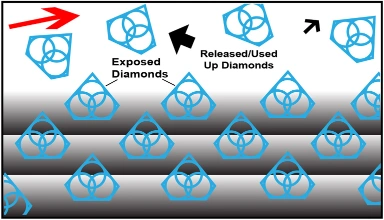
Sharpest And Finest Quality Diamonds
The newly exposed diamonds don’t effect diamonds already working on the material. Unlike many other diamond bonds, diamonds in a SMART CUT® Bond remains sharp and grow sharper with each cut, prolonging product life and consistent performance.
Step 2
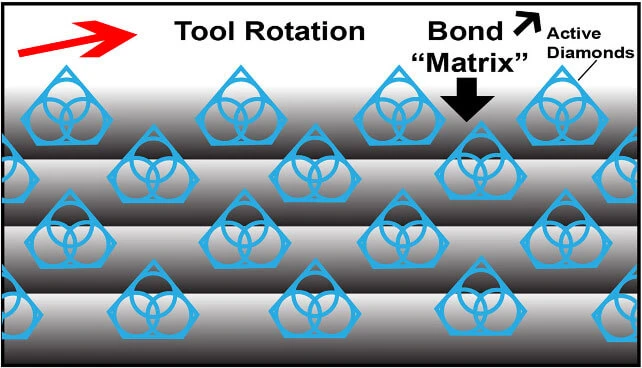
Diamonds or CBN Crystals
Diamonds or CBN Crystals are activated only at the exposed layer. As Bond Matrix layer begin to wear out, diamonds in a new Bond Matrix layer are immediately activated, substituting the already used up diamond layer. The SMART CUT® Diamond Hybrid Bond makes sure every diamond is in the right place and at the right time, working where you need it most.
Step 3
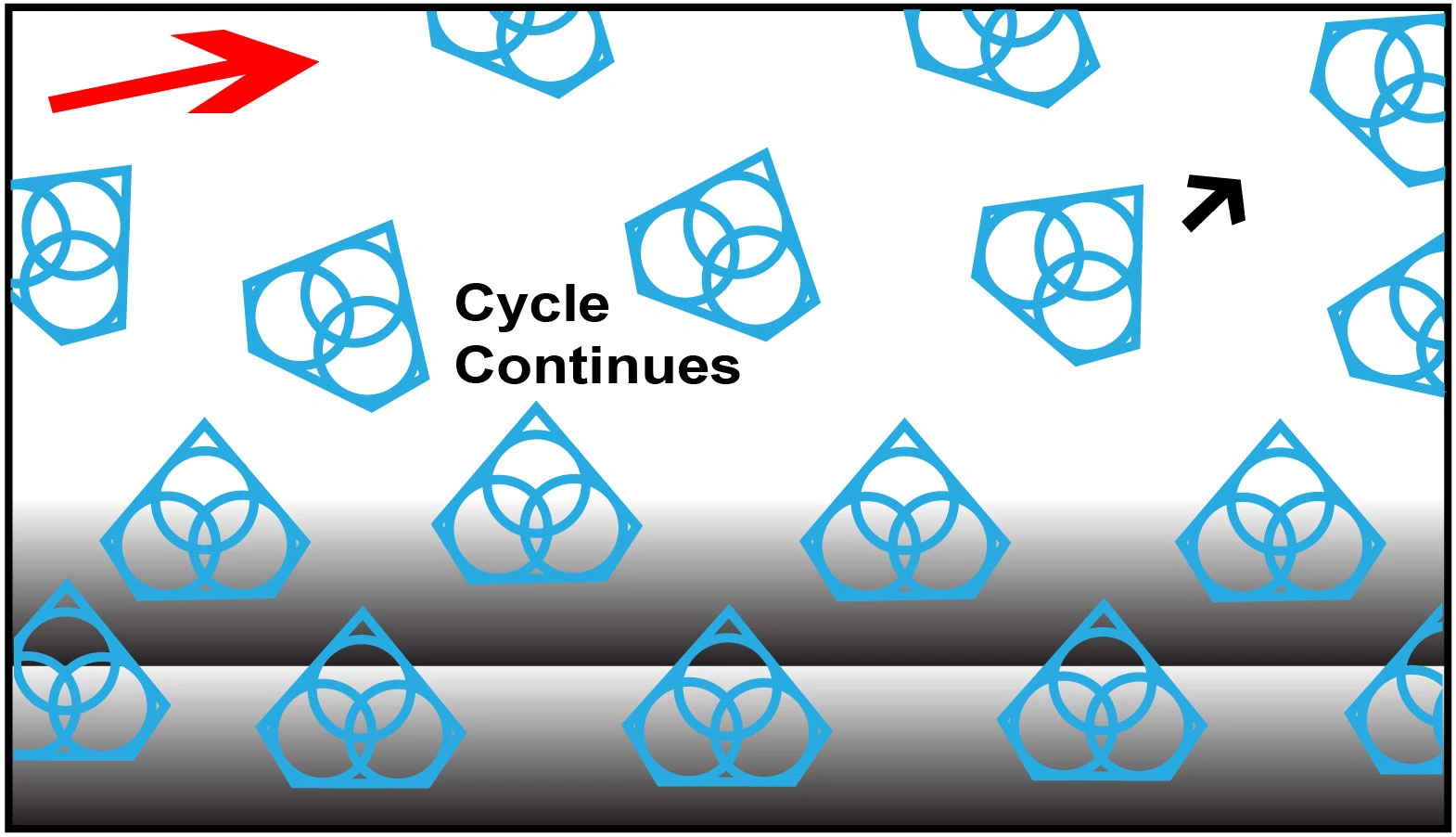
Advanced Formulated Open Diamond Bond Design
This advanced formulated open diamond bond design insures minimal chipping, fast cut, constant speed of cut, minimal cutting noise, and most important of all, consistent performance.
Better Cut Quality
& Less Material Deformation
Diamond & CBN tools with SMART CUT® technology make any work much faster & easier, Thousands of sharp and high quality diamond or CBN particles oriented and evenly distributed on both matrix, allow most jobs to be completed by applying little or only moderate amount of pressure even on the most toughest and challenging materials. Freeing the user from constantly having to dress and renew the diamond layer.
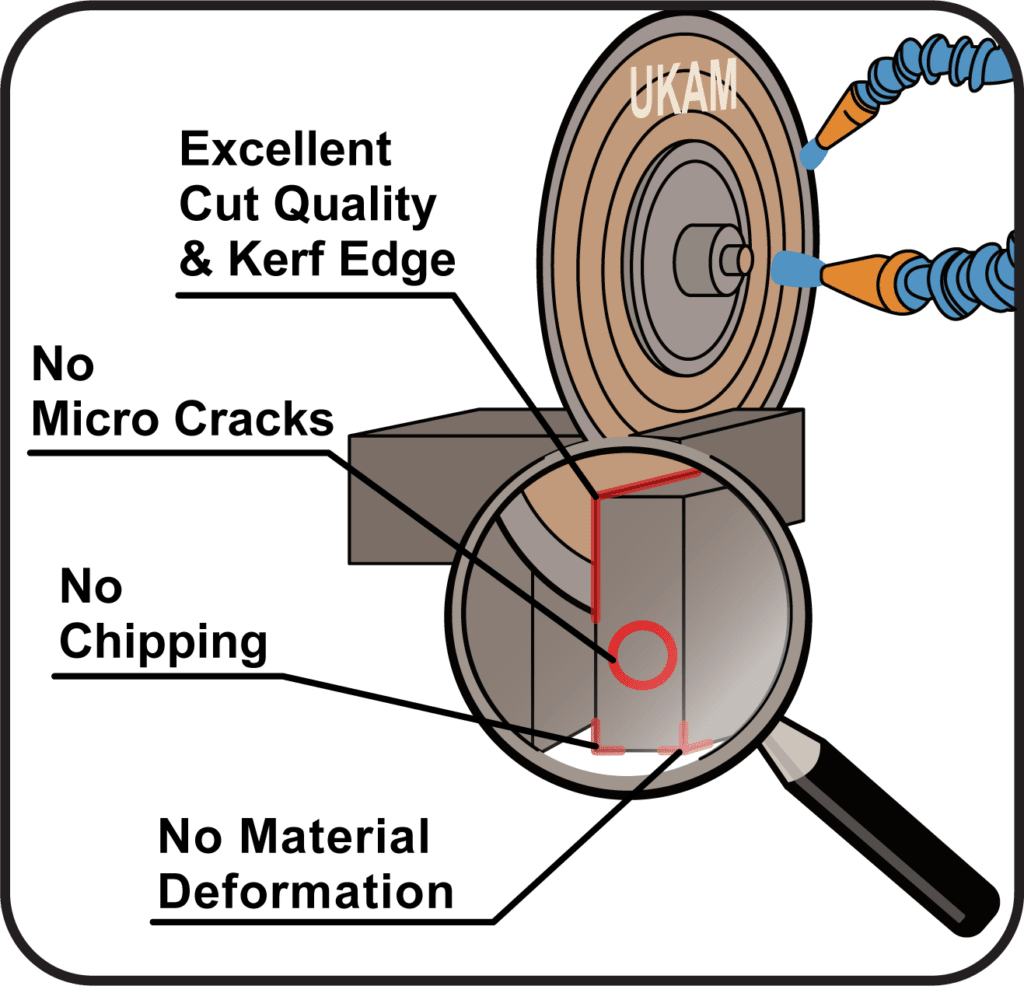
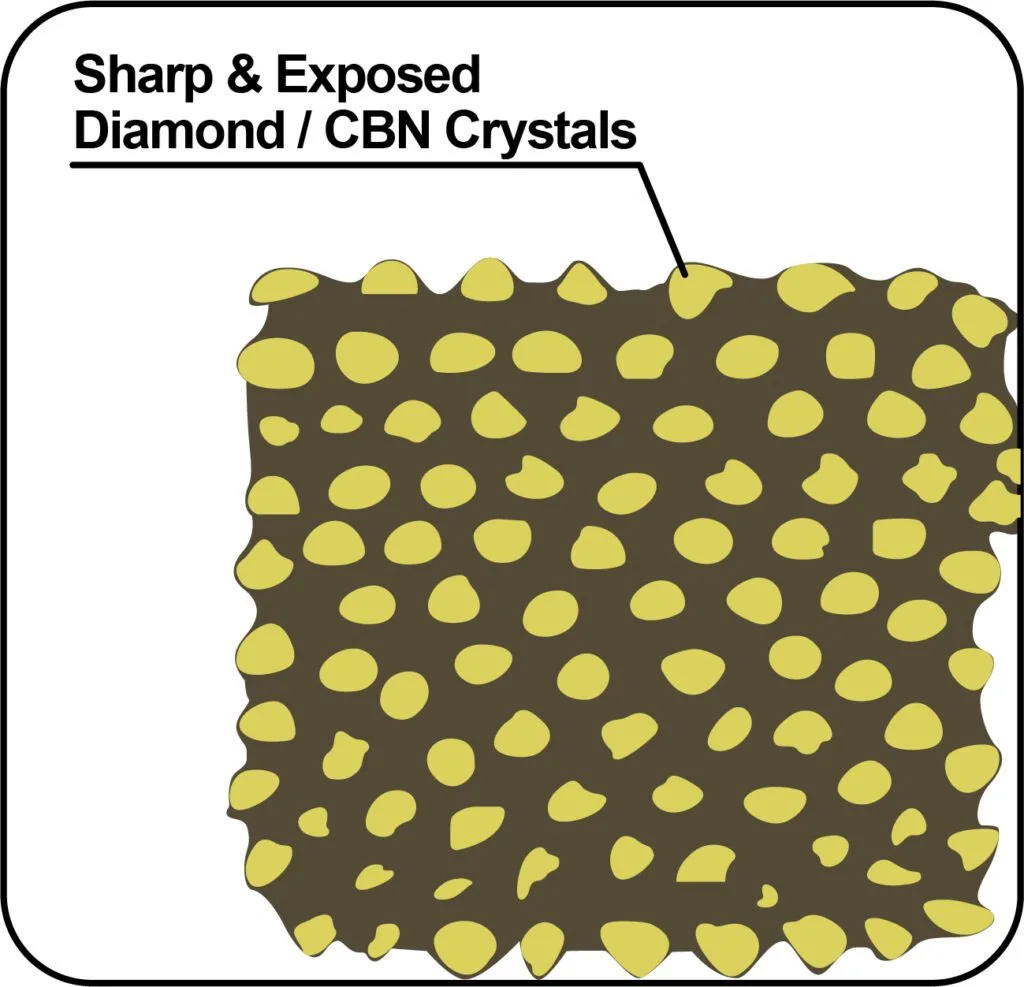
No Glazing
Diamond & CBN tools with SMART CUT® technology require minimum dressing, the bond renews itself.

More Consistent Performance
Diamond & CBN Wheels are produced using only the highest quality raw materials are used in manufacturing process. Utilizing world class quality control, inspection, and measurement equipment. Highly Experienced Engineers constantly monitor and control all material input & output at all stages of manufacturing process. Insuring product consistency for use in demanding & sensitive applications SMART CUT® DIAMOND & CBN wear evenly, and are known for their consistency. You will get consistent cutting speed, and overall consistent performance, with minimum amount of dressing.
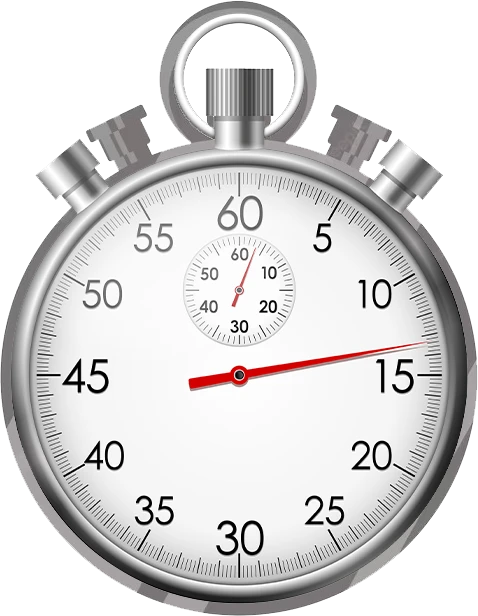
Faster Cutting Action
Diamond & CBN tools made utilizing SMART CUT® technology are much more aggressive than your conventional tools. They can cut faster, while still leaving behind a smooth finish free of material deformation.

Longer Life
In most cases tools manufactured utilizing SMART CUT® technology, will outlast other conventional material (sintered), resin, and nickel bonded diamond & CBN tools. SMART CUT® diamond & CBN tools are more sturdy than tools manufactured with conventional technologies. They are capable to retain their form and bond configuration all the way through the tools life.

Best Performance & Value on the Market
SMART CUT® Diamond & CBN Wheels are the best investment you can make! Although we may not always be the lowest cost solution provider. Our Diamond & CBN wheels can provide the best ROI. Designed for users that understand and appreciate quality. They will more than pay for themselves in terms of overall performance and provide best Return on Investment.
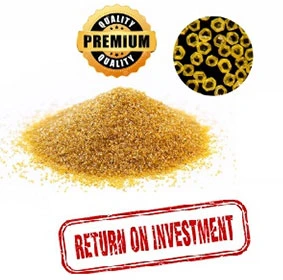
Manufactured Using The Highest Quality Raw Materials
Only the highest quality synthetic diamonds and raw materials are used in the manufacturing process. The highest quality standards and product consistency is maintained, using sophisticated inspection and measurement equipment.
Why Choose Us?
Optimize your application to ultimate level of efficiency
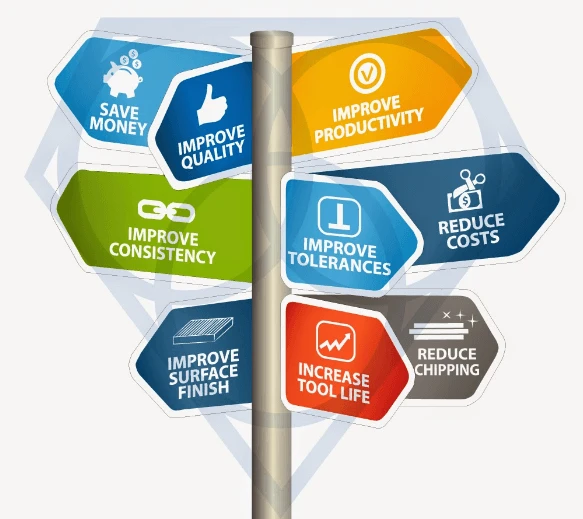
- Unmatched Selection For Many Applications
- Unmatched Technical Support & Expertise
- Superior Quality & Consistency
- Super Technology & innovation
- Immediate Worldwide Delivery
- American Based Manufacturer
-
Custom
Manufacturing - Better Value manufacturer Direct Price
Diamond & CBN Wheel
Selection Variables

Diamond Concentration
Diamond Concentration – Diamond Concentration is still a factor in determining the life and cutting speed of your Diamond Sectioning/Wafering Blade. Higher diamond concentration is recommended and usually used for cutting softer and more abrasive types of materials. However, the trade off is significantly slower cutting speed. Low diamond concentration is recommended and widely used for cutting ultra hard and brittle materials.
Low Diamond Concentration - typically low concentration wafering blades should be for cutting ultra hard and brittle materials such as ceramics and glass. In Low Concentration Wafering Blades, diamond works by fracture process. Pressure on each diamond crystal/particle is higher which provides enough stress to chip off small flakes in the cut.
High Diamond Concentration - High concentration diamond wafering blades are recommended for cutting metals, plastics and polymers. In this application, materials cut by a plowing mechanism. In this applications diamond plough through the material, work hardened strips of materials become brittle and break off. The greater number of diamond by volume, the quicker the cutting action will be. Increasing the number of diamond s also lowers the per unit force. For metals where it is possible to induce deep deformation layers, a lower per unit force is desirable to reduce the deformation during the cut.

Blade Thickness
Wafering blade thickness typically ranges from .006” to .040” (1mm). Thinner and thicker wafering blade are available, frequently from stock upon request. Kef thickness typically increases with blade diameter (in proportion to diameter of the blade). Kerf is the amount of material removed from the material/sample due to the thickness of blade passing though the material/sample. Blade thickness is important for users requiring most minimal amount of material loss during sectioning
For example if the user requires precision position of the cutting plane relative to the detail on the sample (IC circuit for example), a thinner and smaller diameter blade would be best for this application. Blades ranging from 3” to 5” (75mm to 125mm) in diameter and thickness .006” to .015” (0.2mm to 0.4mm) would be bet suited for this purpose. There are large variety of factors that will contribute to optimal blade thickness for your material/application Including your desired cutting speed, load/feed rate, material diameter, thickness, hardness, density, and shape. As well as skill & experience of the operator. Thicker wafering blades are more stiff and can whistand higher loads/feed rates. Another advantage of thicker kerf blades is they are more forgiving to operator error and abuse. Thicker kerf blade are recommended for use in environment where large number of individuals will be sharing and using same equipment. Perfect for less experienced and novice saw operators, such as in University laboratory.
.

Diamond Particle/Grit size
Diamond Mesh Size plays a major role in determining your cutting speed, cut quality/surface finish, level of chipping you will obtain, and material microstructure damage you will obtain. Diamond Mesh size does have considerable effect on cutting speed. Coarse Diamonds are larger than finer diamonds and will cut faster. However, the tradeoff is increase in material micro damage. If you are cutting fragile, more delicate materials then finer mesh size diamond wafering blades are recommended.

Bond Type
Metal bonding offers long life and durability, while resin bonding creates less heat, provides better surface finish and is well suited for cutting hard, delicate or brittle materials.

Blade Outside Diameter
typically wafering blade diameters range form 3” (75mm) to 8” (200mm). Wafering blade diameter should be selected based on material diameter and thickness being cut. Smaller diameter wafering blades are thinner than the larger diameter blades and are more prone to bending and warping. Although large diameter blades are thicker, they are typically used for cutting larger and heavier samples at higher loads and speeds than smaller blades

Feed Rates
load/feed rate applied to wafering blades typically vary from 10-1000 grams. Generally, harder specimens are cut at higher loads and speeds (e.g. ceramics and minerals) and more brittle specimens are cut at lower loads and speeds (e.g. electronic silicon substrates). The Speeds/RPM’s you are using, shape/geometry of the specimen, and how the specimen is being clamped/hold in place will affect the load that can be used for your application.

Bond Hardness
Ability of the bond matrix to hold diamonds. As the hardness of the bond is increased, its diamond retention capabilities increase as well. However the trade off is slower cutting speed. Life of the diamond blade is usually increased with hardness of its bond matrix. Bonds are designated on their scale of hardness from Soft, Medium, and Hard. There are dozens of variations and classification schemes based on bond degree of hardness or softness.
Using diamond blades with optimum bond hardness for your application is important to successful precision diamond sawing operation. Bond matrix that is too soft for the material being cut will release diamond particles faster than needed, resulting in faster wear and shorter diamond blade life. On other hand bond matrix that is too hard will result in much slower cutting speeds and require constant dressing to expose the next diamond layer. As rule of thumb, harder materials such as sapphire and alumina generally require a softer bond. Whereas softer and more brittle materials require a harder bond.

Blade Speeds/RPM’s
Most wafering blades are used between 50 to 6,000 RPM’s Typically harder and more denser materials such as Silicon Carbide, are cut at higher RPM’s/speeds Where more brittle materials such as silicon wafers and gallium arsenide are cutting at lower RPM’s. Low Speed saws RPM’s are typically limited from 0 to 600 RPM’s. Where high speed saws offer much large variety of cutting speeds from 0 to 6,000 RPM’s.
Diamond & CBN Wheel
Selection Variables

Diamond Concentration
The concentration of diamond or cubic boron nitride (CBN) in grinding wheels significantly influences both the wheel's lifespan and its effectiveness in grinding. Typically, a higher concentration of these abrasives is recommended for softer, more abrasive materials to enhance the durability of the wheel by spreading the wear across more abrasive particles. This setup, however, may reduce the grinding speed due to the increased friction from the many cutting points involved.
Wheels with a lower concentration of diamonds or CBN are best suited for grinding ultra-hard and brittle materials, such as ceramics and glass. With fewer abrasive particles, each one exerts more force, leading to a precise material removal process through micro-fractures. This approach helps to minimize wheel wear while efficiently grinding hard materials.
Conversely, for grinding softer or less brittle materials like metals, plastics, and polymers, wheels with a high concentration of diamonds or CBN are preferred. These wheels operate by plowing through the material with a dense array of abrasive particles, causing work-hardened strips to become brittle and break away. The large number of abrasives not only speeds up the grinding process but also reduces the force each particle exerts, helping to prevent deep deformation in metals.
Selecting the right concentration of diamond or CBN in grinding wheels depends on the material properties and specific grinding requirements. High concentrations generally yield faster material removal on softer materials, whereas lower concentrations are crucial for detailed and precise grinding of hard and brittle materials.

Diamond & CBN Wheel Thickness
The thickness of diamond and CBN (Cubic Boron Nitride) grinding wheels varies widely to suit different applications and material processing needs. For precision grinding tasks, wheels are typically thinner, ranging from about 0.5 mm to 10 mm, allowing for meticulous and detailed material removal. Cut-off wheels, used primarily for slicing through materials, tend to be even thinner, with thicknesses from 0.1 mm to 3 mm to facilitate precise cuts. Conversely, surface and tool grinding wheels, which are used for more extensive surface grinding, generally have thicknesses from 3 mm to 40 mm. For heavy-duty grinding operations involving large workpieces or substantial material removal, wheel thickness can be significantly greater, often from 10 mm up to 100 mm or more.
The thickness of a diamond or CBN grinding wheel directly impacts its grinding performance. Thicker wheels facilitate higher material removal rates, making them suitable for heavy-duty grinding tasks but tend to generate more heat and require more power. Thinner wheels excel in precision grinding tasks due to their ability to produce finer finishes and more detailed work. They also dissipate heat more effectively, minimizing thermal damage to both the wheel and the workpiece.
Stability increases with wheel thickness; thicker wheels resist bending under pressure, thereby enhancing their lifespan and ensuring consistent performance. However, they may require multiple dressings over their lifespan to maintain effectiveness. Thinner wheels, while more flexible for precision work, wear out quicker as they contain less material for dressing.
.
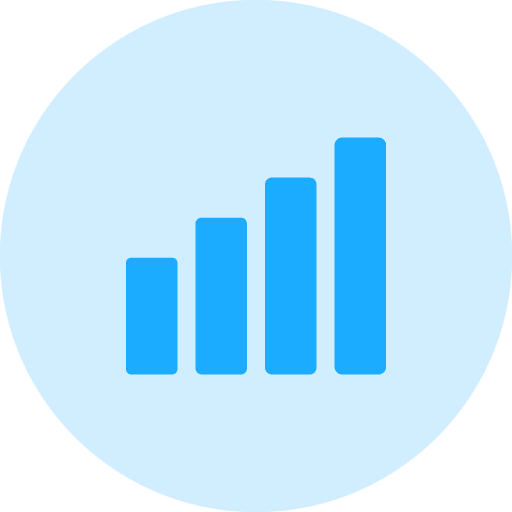
Feed Rates
Feed rates in diamond and CBN grinding wheels are essential for achieving optimal grinding performance, balancing material removal, surface finish, and wheel life. The rate at which the workpiece is fed into the wheel depends on factors such as material hardness, wheel type, depth of cut, and the desired surface finish. Harder materials require slower feed rates to prevent damage and excessive wheel wear, while softer materials can tolerate higher feed rates. Deeper cuts also necessitate slower feed rates to avoid overloading the wheel.
Faster feed rates increase productivity but may sacrifice surface finish and reduce wheel life, while slower feed rates provide better control, finer finishes, and longer wheel life. Properly balancing the feed rate based on the material and grinding conditions ensures efficient grinding, quality results, and longer-lasting wheels. Adjusting the feed rate to match the needs of the specific task is key to optimizing performance and prolonging the life of diamond and CBN grinding wheels.
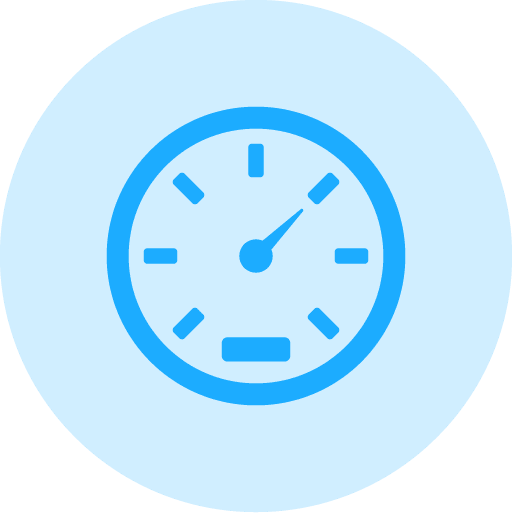
Diamond & CBN Wheel Speeds/RPM’s
The RPM (Revolutions Per Minute) of diamond and CBN grinding wheels plays a key role in determining grinding performance. Harder materials like ceramics and hardened steel typically require lower RPMs to prevent overheating and excessive wear, while softer materials can be ground at higher RPMs. Larger wheels, due to their size, should run at lower speeds compared to smaller wheels, which can handle higher RPMs.
For fine precision and smooth surface finishes, lower RPMs are ideal, providing better control and reducing the risk of surface damage. Higher RPMs can be used for faster material removal but require careful attention to heat generation and wheel wear. Excessive RPMs can cause overheating, damaging both the wheel and the workpiece, particularly with heat-sensitive materials.
In general, diamond and CBN wheels operate effectively within a range of 3,000 to 6,000 RPM, depending on the material and wheel size. Adhering to optimal RPMs ensures efficient grinding, longer wheel life, and better overall results.

Diamond Particle/Grit size
In diamond and CBN grinding wheels, the particle or grit size profoundly influences several aspects of the wheel's performance. Coarser grits enable faster material removal rates due to their aggressive cutting action, which is beneficial for increasing productivity in scenarios where high grinding speeds are necessary. Conversely, finer grit sizes produce a smoother finish, as the smaller particles make less aggressive cuts, reducing surface roughness. This is crucial for applications that demand a high-quality finish.
The amount of chipping during grinding is also impacted by the grit size. Finer grits typically result in less chipping, making them suitable for grinding brittle materials or when precise, clean edges are essential. However, coarser grits might cause more significant damage to the material’s microstructure because of their aggressive nature, which could be problematic in precision engineering applications where the integrity of the material is critical.
Selecting the appropriate grit size is vital for optimizing both the material removal rates and the quality of the finished surfaces. Coarse grits are preferred for rapid material removal when finish quality is less critical, while finer grits are ideal for achieving high-quality finishes and minimizing damage, particularly in delicate or precise grinding tasks.

Bond Hardness
For diamond and CBN grinding wheels, the hardness of the bond matrix is crucial in determining how effectively the diamonds or CBN particles are held in place. As the hardness of the bond increases, so does its capability to retain these abrasive particles, which can extend the life of the grinding wheel. However, a harder bond typically results in a slower grinding speed.
Grinding wheels are categorized based on the hardness of their bonds, ranging from Soft, Medium, to Hard, with numerous variations and classifications within these categories to suit different materials and applications..
Selecting the optimal bond hardness for your specific application is essential for achieving efficient and precise grinding results. A bond that is too soft for the material being ground tends to release the abrasive particles too quickly. This premature release can lead to faster wear and a reduced lifespan of the grinding wheel. Conversely, a bond that is too hard can impede the grinding speed, .
necessitating frequent dressing of the wheel to expose new layers of abrasive particles.
As a general guideline, harder materials such as sapphire and alumina benefit from grinding wheels with softer bonds, which allow for more aggressive material removal without compromising the integrity of the wheel. Softer or more brittle materials, on the other hand, are better matched with harder bonds, which help prevent excessive wear and maintain the wheel's effectiveness over time.

Diamond & CBN Outside Diameter
These diameters are carefully chosen based on the specific needs of the application, the properties of the material being cut, and the capabilities of the cutting machine. Resin diamond cut off blades & cutoff wheels, which are available in sizes ranging from 1 inch to 20 inches in diameter, offer varied capabilities based on their size. The diameter of the blade should be chosen with consideration to the diameter and thickness of the material being cut. Smaller diameter blades, which tend to be thinner, are more susceptible to bending and warping during use. On the other hand, larger diameter blades, being thicker, provide greater stability and are typically employed for cutting larger and heavier materials. These larger blades can handle higher loads and speeds, making them suitable for more demanding cutting tasks.
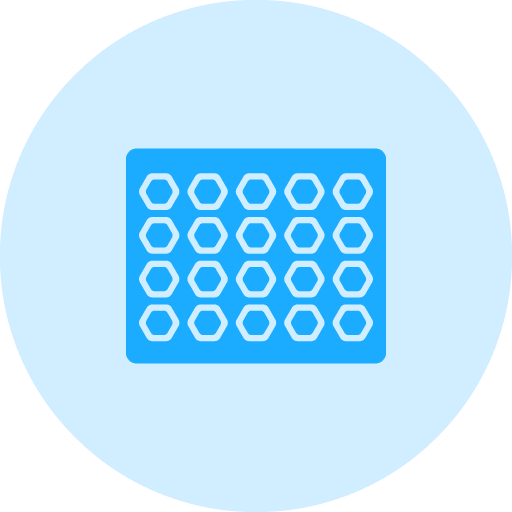
Diamond & CBN Bond Type
Diamond and CBN grinding wheels are available with various bond types, each suited for specific grinding applications.
Resin Bond wheels are popular for tool, cutter, and precision grinding due to their self-sharpening properties and fast cutting speeds. They offer a balance between material removal, wheel life, and finish.
Metal Bond wheels provide durability and long life, excelling in high-precision applications like grinding hard materials (e.g., ceramics, glass, hardened steels). Though slower cutting, they are highly wear-resistant.
Vitrified Bond wheels are rigid and heat-resistant, ideal for high-speed grinding. Their porous structure aids in chip clearance and cooler operation, making them perfect for precision grinding.
Electroplated Bond wheels feature a single layer of abrasives bonded with nickel, maintaining excellent form stability. They are used for precise profile grinding but have a shorter lifespan.
Hybrid Bonds combine resin, metal, or vitrified components to balance cutting efficiency, finish, and wheel life, making them suitable for demanding grinding tasks.
Selecting the appropriate bond type ensures optimal performance, finish quality, and wheel longevity for specific materials and grinding operations.
Related Products
SMART CUT® DISCO DIAMOND & CBN WHEELS
SMART CUT® 15V9 DIAMOND & CBN WHEELS
SMART CUT® 15A2 DIAMOND & CBN WHEELS
SMART CUT® 14V1R DIAMOND & CBN WHEELS
SMART CUT® 14F1R DIAMOND & CBN WHEELS
SMART CUT® 14F1R SCHMIDT TEMPO DIAMOND & CBN WHEELS
SMART CUT® 14F1R LOROCH DIAMOND & CBN WHEELS
SMART CUT® 14F1M DIAMOND & CBN WHEELS
SMART CUT® 14BB1 DIAMOND & CBN WHEELS
SMART CUT® 14A1R DIAMOND & CBN WHEELS
Recently Viewed Products

ARE YOU USING RIGHT TOOLS
FOR YOUR APPLICATION?
LET US
HELP YOU
HAVING ISSUES WITH
YOUR CURRENT TOOLS?
Knowledge Center
02
Nov
Coolant is one of the most overlooked variables in the overall diamond or cbn tool machining process. Effective and proper use of coolant and recalculating coolant system will pay off in terms of improved surface...
29
Aug
Selecting the Right Coolant Method for your Diamond & CBN Tools
Coolant is one of the most important factors in CNC machining when using diamond and CBN tools. These tools are made to cut and grind very hard materials, which naturally produces high amounts of friction...
02
Jun
How to Selecting Right Diamond Tools for your application
Selecting the appropriate Diamond & CBN Tool specification is a crucial aspect of achieving your objectives. Opting for the ideal specification not only yields optimal results but also ensures the best return on investment. Conversely,...
02
Jun
How to properly use Diamond Tools
UKAM Industrial Superhard Tools manufactures precision diamond tools for a large variety of applications, materials, and industries.
Share this Article with Friend or Colleague
Metal Bonded Diamond Tools are “impregnated” with diamonds. This means that selected...
02
Jun
Why use diamond
Diamond is the hardest material known to man kind. When used on diamond/tools, diamond grinds away material on micro (nano) level. Due to its hardness Diamond will work all types of materials from...
02
Jun
Diamond vs CBN (cubic boron nitride) Tools
Cubic Boron Nitride (CBN) is a synthetic material that is renowned for its exceptional hardness and high thermal stability. It is composed of boron and nitrogen atoms arranged in a crystal lattice structure, similar to...
02
Jun
What is Diamond Mesh Size and how to select best one for your application
Diamond grit size can be defined as the size of the diamond particles used in the bond matrix. The larger the diamond particles (grit size) the faster the tool will cut.
Share this Article with Friend or...
02
Jun
What is Diamond Concentration and which to use for your application
Diamond concentration is measured based on the volume of diamond within a section of the tool. It is typically defined as Concentration 100, which equates to 4.4 carats per cubic centimeter of the diamond layer...
17
May
Choosing The Correct Diamond Bond Type
Selecting the appropriate diamond bond type for specific applications is crucial for several reasons. Diamond bond type directly affects the tool's performance, efficiency, and longevity. Different bond types determine how well a tool can withstand...




























































































